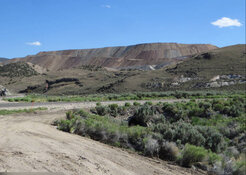David Skarica: Part of it is sentiment, and part of it is the monetary outlook. And part of it is the cycle of the stock market.
On the sentiment side, I watch a few indicators: Investors Intelligence and the American Association of Individual Investors (AAII). Essentially, these are sentiment polls. Right now, Investors Intelligence levels are showing very high bearish readings, much like the AAII reading in late July showed more bears than bulls. In late June, early July, one AAII reading had the most bears since the 2008–2009 bottom. Investors Intelligence showed something similar. A few weeks ago it showed the highest number of bears since April 2009, which, of course, was the start of the bull market and rally.
To get a bear market, you need panic and people selling. But if people are already bearish, it is very difficult to get that selling pressure.
In the monetary outlook, at any point now the Fed is going to start more quantitative easing. That's usually very positive for equities. Then what people have to remember is that everyone's likely to get really bearish on the economy. We had a really great unwinding of leverage in 2008, and I don't see that occurring again. I will talk about that with my third point. That is why I don't see a huge amount of downside in stocks. Even if the S&P were to drop to 900, that is when quantitative easing would really begin, big time.
Part of my analysis in a book I have coming out in November (The Great Super Cycle: Profit from the Coming Inflation Tidal Wave and Dollar Devaluation, John Wiley & Sons), examines the last three secular bear markets: between 1900 and 1920, the start of 1929 to 1949, and 1966 to 1982. Those were all 15–20 year periods when equities went sideways. There are usually two big bear markets, and they happen in the first half of the secular bear market. The examples were 1907 and 1914, 1929 and 1937, and 1970 and 1974. In the second half of the bear market, more muted moves occur in the stock market, combined with much higher inflation. That's where I think we are.
The rally we're seeing in the stock market is very similar to the 1908 or 1975 rallies, and those were followed by long-term trading ranges rather than big dips. The low of 666 on the S&P that was reached last March will probably hold, but inflation adjusted, we actually could go lower. If we get a drop of another 10%–15% in current levels in the stock market, they're going to come in with quantitative easing, which will actually probably lift stock prices, even if it doesn't help the economy.
TGR: You're saying that if the market starts to dramatically slide, the government is going to come in with some more money to prop up the economy again. But America doesn't really have any money.
DS: They're going to print it.
TGR: Won't that just prolong the inevitable?
DS: What will happen in this cycle is very similar to what happened in the late 1940s or in the early 1980s. In those cycles when the bear market ended, the Fed and the government raised interest rates and the money supply dropped. Everything dropped in price, and that cleansed the system. But I just don't think they're ready to do that yet. If you look at interest rates, we're coming off a secular low. That tightening cycle has to be the end. I don't see that occurring for quite a while. The Brits had to do this after the Second World War when the pound ceased to be world's reserve currency. They essentially devalued way into the early 1980s, a 35–40 year period. There's no reason why the U.S. can't slowly devalue over that long as well.
TGR: What's your near-term market outlook, David?
DS: That is really difficult because if you had talked to me in late June or early July, I was really bullish because of the terrible sentiment we saw. I still have a muted bullish outlook here. One chart I have in my newsletter compares the 1907–1909 period with the current period. The 1907–1909 period saw almost a 50% drop over a two-year period followed by a very strong reaction rally, followed by consolidation like we saw recently, followed by a second move higher. If that correlation continues, it means we would be at the top of the market in the first or second quarter of next year, and the S&P would rally to about 1,300.
In the very short term, we could see one more drop in the fall before we rally, but I really think those lows of May–June are going to hold. We could see a pullback. But after that pullback, we will be headed higher because of the quantitative easing.
What people have to understand is that this is a global market. Don't be so focused on the U.S. market. If you look at Turkey, the market there has actually broken above its 2007–2008 pre-crisis high. Brazil and India are within a few percentage points of their respective pre-crisis highs. When the U.S. market broke down to new lows in late June, all of the Asian markets essentially held their lows and some went higher.
TGR: But if the U.S. continues to print money, doesn't it risk losing its status as the world's reserve currency?
DS: I think that's a question of when it's going to happen and not if. This is why it will lose its status: about 75% of its debt is short-term oriented, meaning two to seven years in duration. That means that if you run a deficit of $1.2 trillion a year over the next five to seven years, you're going to rack up $5–$7 trillion dollars in debt. And you're going to have to roll over about $8–$9 trillion of the current $13 trillion in net debt. That means you're going to need between $10 and $15 trillion to cover the debt. They're going to do that by printing money.
TGR: Doesn't it get to a point where they're not going to repay their debt?
DS: I think they'll repay it because they can just print money to repay it. It's not like in Argentina where you have to do a partial default because some of your debt is issued in another currency. They can just print the money and repay it. I don't think default is ever a problem.
The real risk is more in these unfunded liabilities. You're going to see what happened in Japan happen in the U.S. They're going to raise the taxes and the outlays on Social Security and then reduce the amount you receive. That is more where I see the risk rather than in defaulting on foreign debt.
TGR: So you don't believe a massive crash is imminent in the U.S. economy.
DS: I think what you're seeing today is what's going to continue; it's going to be more depressing, like Chinese water torture.
TGR: You mentioned earlier that some of the foreign markets continue to do quite well despite the economic problems in the U.S. What will the role of these emerging markets be in tomorrow's economy?
DS: I think their role is consumption. We can talk about how their per-capita GDP is much, much lower, but most of these economies do not have the huge personal or federal debt load that the U.S. has. This is where the emerging consumer is going to come from. You have 3.6 billion people in Asia as opposed to 300 million in the States. If you can generate one-twelfth of the per-person buying power of the U.S, the total dollar amount is going to be equal.
I still think the U.S. is going to play a really important role in the new global economy—global finance. That's where the U.S. can really serve; it can still be a source of capital for these markets and help these companies raise money. There's definitely a role for U.S. corporations going ahead, and obviously technology corporations—you know, Apple (NASDAQ:AAPL), Microsoft (NASDAQ:MSFT)—these are still top-tier companies. Let's face it, the iPhone is a real niche brand, and as Asians get richer, they're going to want that sort of consumer product.
TGR: What are some companies you like with some strong emerging markets assets?
DS: I really like Petrobras (NYSE:PBR). I like oil companies that are outside of the United States because Americans have no regulation, and then a disaster happens, and then they overregulate like crazy. I think you want oil companies that have most of their properties outside of the U.S. I really like Petrobras for that reason, and the Canadian oil company Suncor Energy Inc. (NYSE:SU; TSX.V:SU), which is an indirect play on China and rising commodity prices going forward.
TGR: Do you mostly like Petrobras because it owns the big Tupi oilfield?
DS: Yes, in Tupi they have one of the largest offshore oilfield discoveries in the world. Most of their properties are either offshore Brazil, or they are in the South Pacific. Brazil and China are becoming unique partners in that Brazil is basically exporting raw materials for China, and Brazil buys some of the produced goods back from China. So, a lot of Petrobras' oil is going to be served directly to China.
TGR: And what is it about Suncor you like?
DS: It's in the Canadian oil sands. President Obama once called it "dirty oil." After what happened in the Gulf, it doesn't look so dirty anymore. It's right next to the U.S., but you're not at the whim of U.S. environmental regulations. Politically, you're very stable. When you're up in the oilfields of Canada, that's about as safe as you get.
That stock has gone nowhere for a while, and because of that there's been valuation compression. So it's become a pretty good value play as well.
TGR: What does the stagnating U.S. economy mean for gold?
DS: It means there are going to be higher gold prices because you're getting increased inflation, and gold is a hedge against that. Because the value of the dollar is going to decrease, there's going to be more consumer demand for gold in the United States.
Also, in deflation, consumers get really worried and they hoard gold. That happened in the early 1930s before they made gold illegal to own, so deflation or inflation is really positive for the gold price because people are going to try to hedge with owning gold under those circumstances.
TGR: You're not really a gold bug, but you're certainly bullish on gold.
DS: Well, one thing I really believe is that the gold bull market usually ends when the Dow-to-gold ratio—the number of ounces of gold it takes to buy one share of the Dow—goes about 1.5-to-1. That's what happened in 1932; that's what happened in 1980. Right now we're still 8-to-1, 9-to-1. There's a long way to go.
TGR: Do you have a price projection for gold?
DS: I am really conservative in my price prediction, but last year I was thinking we would go to $1,100–$1,200, which we did. I would say by the end of 2011, I'd be pretty happy with $1,500 gold. But because quantitative easing might start again, I wouldn't be surprised if it was a lot higher than that.
TGR: How are you playing gold in this environment?
DS: I really like the equities, and the reason is because if you look at the ratios like the XAU-to-gold or the HUI-to-gold stocks, the XAU-to-gold usually roughly trades historically at 20% of the price of gold. So if gold is $1,000, then the XAU should be at 200. Well, right now the XAU is just over 175, and gold is $1,220. If you took away the financial crisis, this is the lowest all-time ratio of stocks to gold, lower than when they bottomed in 2000.
This tells us that if gold goes over $2,000, then the XAU should be trading at 400. Well, $2,000 in gold is about a 67% gain from $1,200, but 170 to 400 on the XAU is about a 150% gain from the current gold stock prices. I think the equities have more leverage, if they go back to their historical valuations.
TGR: What are some equities you like?
DS: I really like Eldorado Gold Corp. (TSX:ELD; NYSE:EGO). I have to put Kinross Gold Corp. (TSX:K; NYSE:KGC) in there after their most recent takeover.
TGR: You liked Kinross's deal for Red Back?
DS: They overpaid, but I know some guys who know those properties, and I think they're really going to expand the resources on those properties. With gold at $1,500 and an expanding resource base, that would look good in retrospect. Sometimes you have to let these things play out. If you look at Agnico-Eagle Mines Ltd. (NYSE:AEM; TSX:AEM), they did a lot of takeovers in the mid-2000s—and Agnico is another one I like. Agnico lagged for quite a number of years, and then all of a sudden when some of these things started coming to fruition, Agnico was like shot out of a cannon.
I really like these companies with some resources and some production that is expanding. An example of that would be New Gold Inc. (TSX:NGD; NYSE.A:NGD). They have one property in production and one property that they're going to put into production. Another company I really like is Aberdeen International Inc. (TSX.V:AAB).
TGR: Which is effectively a mining mutual fund.
DS: Yes, it's a mutual fund that has control over a lot of their investments, meaning they know what's going on in all their investments because they were in on the original financings. It's even better than a fund right now because the net asset value of Aberdeen is more than a $1 per share, but it's trading at $0.40. When the junior market gets good again, it's going to make up for that deficit in the net asset value.
If you buy something like the Central Fund of Canada Ltd. (NYSE.A:CEF; TSX:CEF.A) right now, you're going to pay a 5%–10% premium on the gold assets in the fund. With Aberdeen you're paying a 60% discount. Aberdeen is a great way to diversify in all these junior companies. I know the guys behind Aberdeen. They're really smart, and they have a history of putting together deals such as that at Consolidated Thompson Iron Mines Ltd. (TSX:CLM), and Avion Gold Corp. (TSX.V:AVR; OTCQX:AVGCF), companies that have real resources and that will go into production.
TGR: You mentioned Avion Gold. It's putting out some decent production numbers in Mali.
DS: Avion is the old Nevsun Resources Ltd. (TSX:NSU; NYSE.A:NSU) property in Mali. The problem you get with some of these properties is a lot of these guys just don't drill the right zone; you need the right geologist. Because of their management and their geologists, Avion is running this mine in Mali a lot more efficiently and a lot more profitably than Nevsun did. Avion has pulled back from $0.80 to the mid-$50s, and it looks like it's going to consolidate down there for a while.
They have cash flow now because they produced over 8,700 ounces of gold in July. Plus there is the possibility of more value coming from their exploration projects.
TGR: What about small caps in West Africa?
DS: Xtra Gold Resources Corp. (OTCBB:XTGR) is in Ghana; that's a very interesting country for gold production: a) it's very stable, and b) there are tons of producing mines—Newmont and all of the large companies are there.
TGR: That's where Red Back's Chirano gold mine is.
DS: Exactly, that's where Red Back is, and they're probably going to be drilling more aggressively to expand the resource in the coming months. I like Xtra as a play in Ghana. That's pretty undervalued in the $1.20–$1.30 range. I don't want to throw numbers around, but I just think they're going to be drilling more. They're going to be able to further expand the resource in Ghana because they're right near a Newmont property.
TGR: Going back to Aberdeen, it also owns Largo Resources Ltd. (TSX.V:LGO). Are you familiar with them?
DS: Yes, I know Largo. I didn't write my newsletter for a year or two, and I worked for Largo. Largo is another company I like longer term because of the assets that they have in Brazil and the Yukon. But if you're someone who's a junior investor and just starting out and you're interested in these deals, I think the more prudent way of owning them is through Aberdeen. Even though I like those companies and those companies are on my list, as a small individual investor you'd want to own those through Aberdeen.
TGR: I suppose it's like a basket of commodities.
DS: It just spreads the risk around, and you're getting it at such a deep discount to net asset value. But by owning it through Aberdeen, if one of these companies goes down, then you know it's only one of their investments. It's not going to be the end of the world.
TGR: Let's talk about silver for a minute. Silver has traditionally traded at about a 15-to-1 ratio to gold. What do you see happening with silver throughout the rest of this year and through 2011?
DS: I really like silver's chart. I would say in 6–12 months' time it will look better than gold because it hasn't broken out yet. Like we saw when gold finally broke $1,000, you get this kind of outperformance jackup. Right now, silver is seeing huge resistance in the $18–$21 range. It really looks like silver is building momentum to break out in the spring. When you're in the up cycle for precious metals, silver is essentially a more elaborate precious metal play. Silver outperforms on the upside and underperforms on the downside. It goes up faster, but it also falls faster.
TGR: What are some small-cap silver plays you like?
DS: That's a tough question. There are very few of them in the small caps. I like Fortuna Silver Mines Inc. (TSX:FVI; Lima Exchange:FVI) because I like its model. It has a silver-producing property that I visited in Peru, and then it has this Mexican property that they're going to put into production. It's got cash flow, it's got potential from another producing property to come, and technically I really like that chart. They're building a big base in the $2–$2.50 range. I think when Fortuna comes out of that, they'll come out quite aggressively.
TGR: Surely that silver chart has you liking other silver plays.
DS: Actually, my favorite silver junior is probably Paramount Gold and Silver Corp. (NYSE.A:PZG; TSX:PZG), which also has projects in Mexico. They're actually on the AMEX so Americans don't have to get a broker to buy them on the Pink Sheets.
Paramount is a good opportunity right now because unfortunately they were on the Russell, but they got kicked off because they don't have a head office in the United States. Their head office is in Ontario. They had to absorb all that selling because they got kicked off of the Russell.
I really like them because they took over Ex-Cal, and on top of that they're going to build this property in Mexico. They have this advantage of a secondary property from a takeover and have the potential to really expand the property that they have in Mexico. On top of that, they have enough cash to basically drill as much as they want to expand this resource.
And they're next to Coeur d'Alene Mines Corp.'s (NYSE:CDE; TSX:CDM) Palmarejo silver mine, which they got when they took over Palarejo Silver and Gold for $1.1 billion in 2007.
TGR: What about some others?
DS: Kiska Metals Corp. (TSX.V:KSK) is one I really like; it's the old Rimfire management. Rimfire was one of my favorite junior companies over the last two years, and they took over Geoinfomatics. As for their Whistler property, what they've essentially done in the last six to nine months—it hasn't been very sexy—but they've essentially done an induced polarization survey to look at Whistler's geology. That's going to allow them to really expand the resource at a rapid rate once they start drilling again. We've seen consolidation on this stock in the $0.70–mid-$0.80 range. I think that this patient approach is going to lead to higher prices going forward.
The nice thing about them too is that they have optioned properties to other companies, so you're going to see a lot of potential in spinning off these other properties. I really like Kiska here.
TGR: Thanks, David. We appreciate your interesting insights.
At the tender age of 18, David Skarica became the youngest person on record to pass the Canadian Securities Course. Skarica, a Canadian and British citizen, is the author of Stock Market Panic! How to Prosper in the Coming Bear Market, (1998), which provided thought-provoking arguments on why this great bull market will end in the most vicious bear market of all history. He is also the author of The Contrarian Who Saved the World, which explains how markets work. His new book, The Great Super Cycle: Profit from the Coming Inflation Tidal Wave and Dollar Devaluation, will be published by John Wiley & Sons in November.
In 1998 Skarica started Addicted to Profits, a newsletter focused on technical analysis and psychology of markets. From 2001 to 2003, Stockfocus.com ranked Addicted to Profits third out of over 300 newsletters in terms of performance. He is also the editor of Gold Stock Adviser and The International Contrarian services, which focus on gold and global investing. Dave has also been a contributing editor to Canadian MoneySaver and Investor's Digest of Canada.
Want to read more exclusive Gold Report interviews like this? Sign up for our free e-newsletter, and you'll learn when new articles have been published. To see a list of recent interviews with industry analysts and commentators, visit our Expert Insights page.
DISCLOSURE:
1) Brian Sylvester of The Gold Report conducted this interview. He personally and/or his family own shares of the following companies mentioned in this interview: None.
2) The following companies mentioned in the interview are sponsors of The Energy Report or The Gold Report: Aberdeen, Avion, Kiska, Fortuna and Largo.
3) David Skarica: I personally and/or my family own shares of the following companies mentioned in this interview: Aberdeen, Kiska, Agnico-Eagle, Eldorado. I personally and/or my family am paid by the following companies mentioned in this interview: None.










































